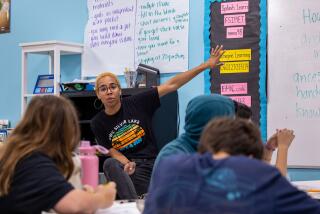Stories of Everyday Life Bring History Alive in Classroom
Sweet dulcimer music wafted out of Room 109 at Oak Avenue Intermediate School in Temple City one recent day.
With a straw hat atop his head and a red bandanna around his neck, Western frontiersman James Smith (also known as eighth-grade social studies teacher John Lopez) hooked his thumb into bib overalls and spun a tale about moving west in 1874.
“My family had that manifest destiny urge,” Lopez drawled, sucking on a corncob pipe. “We moved from Chautauqua, N.Y., to Dodge City, Kan. Out on the Great Plains, it was windy all the time. But we realized wind could be harnessed to get water out of the earth, and we built windmills and had a veritable garden.”
The topic was Manifest Destiny, and Lopez soon had students hanging on every word as he described the corn and wheat James Smith raised, the wars that erupted between the farmers and the cattlemen, and the prickly solution offered by Joseph F. Glidden of De Kalb, Ill., who invented barbed wire.
“One person, one invention, changed the whole region, and Kansas became the breadbasket of the United States,” Lopez said. “And it still is today. We sell grain to the whole world, and not only grain, but what else?”
“Barbed wire,” came one response.
“Beef,” shot out another. That was the response Lopez was looking for.
“Right. And that,” he ended with a flourish, “was a true story of the American West.”
So it goes in eighth-grade social studies, where a new multicultural, literature-based curriculum has been launched this year. Throughout California, schools are using books, diaries and speeches to bring history to life.
Lopez, whose energy is bounded only by classroom walls, uses the James Smith yarn to bring home the values and concerns that motivated early Americans. But his impersonation also prompted a class discussion about Manifest Destiny--the popular 19th-Century belief that God intended Americans to “overspread the continent.”
Historians say this attitude played an important role in the Western Frontier movement by creating an aggressive and confident national consciousness. This, in turn, allowed settlers to justify the displacement of American Indians and the Mexican-American War as they moved west to the Pacific Ocean.
The curriculum also encourages teachers to weave in the contributions of minority groups, which strikes a special chord at schools such as Oak Avenue, where many students are themselves recent immigrants trying to put down roots in a new land.
Recently, the class studied the 1890 Massacre at Wounded Knee, S.D., when the 7th Cavalry opened fire on a band of Sioux Indians and killed 90 men and 200 women and children.
Afterward, Lopez asked the class to write a diary entry pretending they were Sioux who had witnessed the massacre. Several weeks ago, the class read an article called “Chinese Railroad Workers on the Frontier (1865-1890)” and wrote essays about what they had learned.
“We didn’t focus that much on minority contributions before,” Lopez said. “In the text there’s just a mention of the Chinese railroad workers. . . . There was always a picture and a little blurb, but never the significance.”
Now, however, students are being exposed to new perspectives of American history.
“Today I learned that the Chinese were heroes,” student Amy Britton wrote. “The sort of work they were asked to do was grading, tunneling, track-laying. They were paid $1 per day, and $2 per week was deducted from their pay for food,” she said in her essay.
Albert Lee, 13, who is Korean-American, said he knew about the Chinese settlers from watching movies. But in class, “I learned that the Chinese played a very important part in building the railroads and got paid very little,” Albert said. “I hadn’t thought about it too much before.”
After the bell rang, Lopez sat back and spun out his dream scenario for teaching this segment of the class. He would love to have the time to create a frontier community in the class, with some students playing the role of American Indian tribes while others become the invading settlers.
“That’s the best way to learn,” Lopez said. But time is short and another day’s lesson looms. Luckily, Lopez has help from pop culture.
“Many of the students saw the Kevin Costner movie ‘Dances with Wolves’ last year,” Lopez said. “They know all about the Lakota Sioux.”
More to Read
Sign up for Essential California
The most important California stories and recommendations in your inbox every morning.
You may occasionally receive promotional content from the Los Angeles Times.










